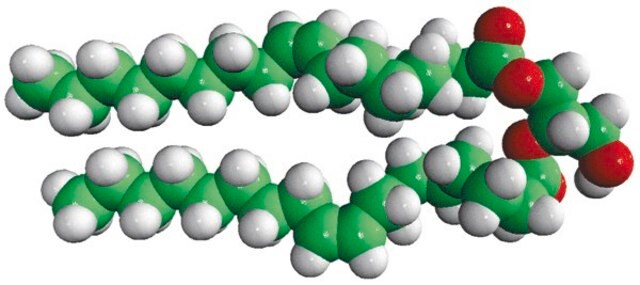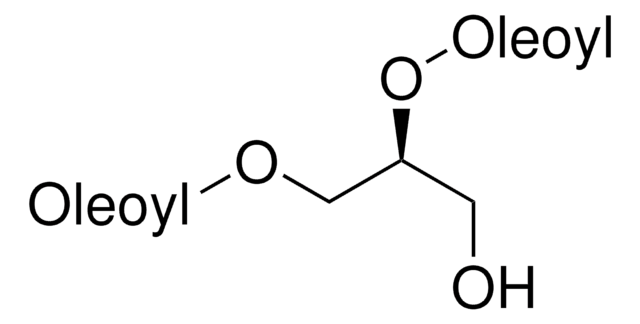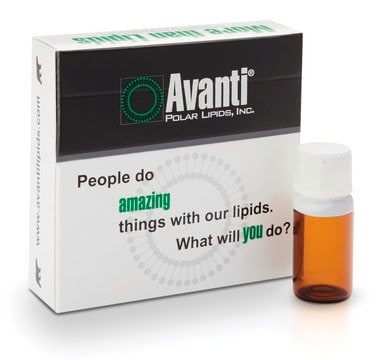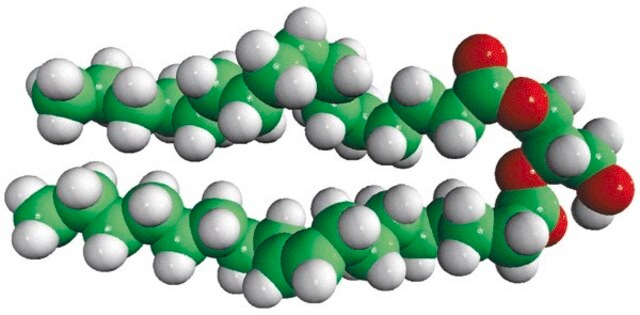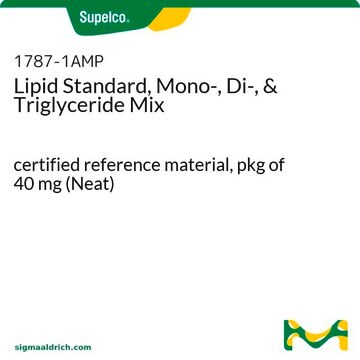800811C
Avanti
18:1 DG
1-2-dioleoyl-sn-glycerol, chloroform
Synonyme(s) :
1-2-di-(9Z-octadecenoyl)-sn-glycerol; DG(18:1(9Z)/18:1(9Z)/0:0); DOG
About This Item
Produits recommandés
Essai
>99% (TLC)
Forme
liquid
Conditionnement
pkg of 1 × 5 mL (800811C-10mg)
pkg of 1 × 5 mL (800811C-25mg)
pkg of 1 × 8 mL (800811C-200mg)
Fabricant/nom de marque
Avanti Research™ - A Croda Brand 800811C
Concentration
2 mg/mL (800811C-10mg)
25 mg/mL (800811C-200mg)
5 mg/mL (800811C-25mg)
Type de lipide
neutral glycerides
neutral lipids
Conditions d'expédition
dry ice
Température de stockage
−20°C
Chaîne SMILES
O([C@H](COC(=O)CCCCCCC\C=C\CCCCCCCC)CO)C(=O)CCCCCCC\C=C/CCCCCCCC
InChI
1S/C39H72O5/c1-3-5-7-9-11-13-15-17-19-21-23-25-27-29-31-33-38(41)43-36-37(35-40)44-39(42)34-32-30-28-26-24-22-20-18-16-14-12-10-8-6-4-2/h17-20,37,40H,3-16,21-36H2,1-2H3/b19-17+,20-18-/t37-/m0/s1
Clé InChI
AFSHUZFNMVJNKX-CSWDEDFYSA-N
Description générale
Diacylglycerol mimicks the effects of the tumor-promoting compounds phorbol esters.
Application
- in the lipid-protein overlay screen assay with Arabidopsis Rho-like GTPases recombinant protein and Arabidopsis plasma membrane H+-ATPase
- in the preparation of the Golgi-like liposomes
- in giant unilamellar vesicles (GUVs) preparation
Actions biochimiques/physiologiques
Conditionnement
Stockage et stabilité
Autres remarques
Dry samples of diacylglycerol in chloroform, using a stream of nitrogen. Dissolve the residue in an appropriate volume of ethanol or DMSO, then dilute to the desired aqueous medium.
Most biological responses saturate at 20 to 250 μM sn-1,2-dioctanoylglycerol. Only sn-1,2 isomers appear to be active.
Informations légales
Mention d'avertissement
Danger
Mentions de danger
Classification des risques
Acute Tox. 3 Inhalation - Acute Tox. 4 Oral - Aquatic Chronic 3 - Carc. 2 - Eye Irrit. 2 - Repr. 2 - Skin Irrit. 2 - STOT RE 1 - STOT SE 3
Organes cibles
Central nervous system, Liver,Kidney
Classe de danger pour l'eau (WGK)
WGK 3
Listes réglementaires
Les listes réglementaires sont principalement fournies pour les produits chimiques. Seules des informations limitées peuvent être fournies ici pour les produits non chimiques. L'absence d'indication signifie qu'aucun des composants n'est répertorié. Il incombe à l'utilisateur de s'assurer de l'utilisation sûre et légale du produit.
EU REACH Annex XVII (Restriction List)
Faites votre choix parmi les versions les plus récentes :
Certificats d'analyse (COA)
It looks like we've run into a problem, but you can still download Certificates of Analysis from our Documents section.
Si vous avez besoin d'assistance, veuillez contacter Service Clients
Déjà en possession de ce produit ?
Retrouvez la documentation relative aux produits que vous avez récemment achetés dans la Bibliothèque de documents.
Les clients ont également consulté
Notre équipe de scientifiques dispose d'une expérience dans tous les secteurs de la recherche, notamment en sciences de la vie, science des matériaux, synthèse chimique, chromatographie, analyse et dans de nombreux autres domaines..
Contacter notre Service technique